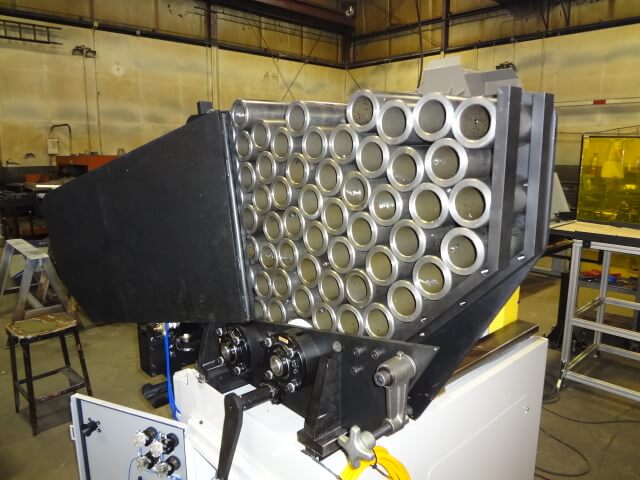What is a Magazine Feeder?
A magazine feeder is a factory automation tool that helps to eliminate many of the hassles of day-to-day production. Designed specifically for feeding bars, tubes, and other horizontally-oriented materials into secondary operations, these advanced and highly engineered systems can process up to 1,500 parts per hour, helping you keep up with production demands. We’ll get into the reasons why magazine feeders improve production environments, but first, it’s helpful to compare a few different types.
Manually Loaded Magazine Feeders
A manually loaded magazine feeder is exactly what it sounds like — a system that feeds bars, tubes, and other shaft-style parts as needed, but it must be loaded by hand. At Feedall Automation, we manufacture two manually loaded systems — the model 1700 and 2214. The 1700 is designed to feed parts for robotic pick and place applications, while the 2214 offers more flexible escapement options.
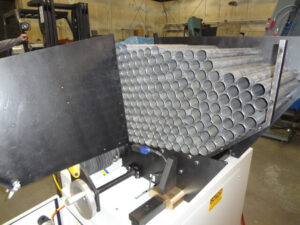
Cart Loaded Magazine Feeders
Cart-loaded magazine feeders enable loading of parts into the feeder via a cart. The parts are easily loaded into the magazine feeder, which then uses an agitator to move parts forward in the process toward the next operation. Because cart-loaded magazine feeders enable more parts to be loaded into the machine at one time, production can continue to move forward with as little delay as possible.
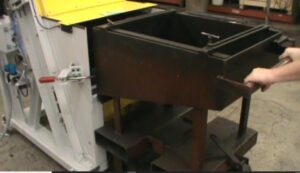
Drop Bottom Bin Loaded Magazine Feeders
Drop bottom bins allow parts to be loaded via a forklift or another piece of equipment capable of holding the bin in the appropriate and secure location for unloading. A drop bottom bin loaded magazine feeder allows more parts to be loaded into the machine in a single operation as opposed to manually loading parts via employees or carts.
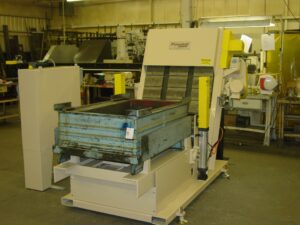
Gantry Bulk Loaded Magazine Feeders
Depending on the application and part, a gantry bulk loaded magazine feeder allows for the loading of the feeder via a gantry crane, which is designed to hold and transport heavy parts and materials. This configuration allows for sizable parts or those that are too heavy to handle manually or in cart-based configurations to be loaded into the feeder.
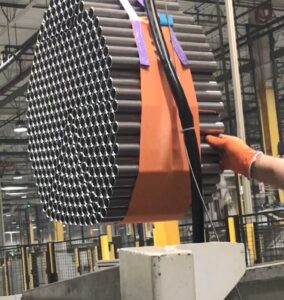
How Magazine Feeders Vastly Improve Production Environments
Increased Utilization of Indirect Labor
Because magazine feeders are automated, there is no need to man them during a shift. Material handling personnel can load parts into the machine once per shift. Using indirect labor like this eliminates the need to have employees handling parts throughout the day for the machine to feed. This translates into significant cost savings, both immediately and over time, and is a great benefit to factories that are looking to increase labor efficiency.
Increased Production Uptime
Plant managers will understand the importance of tracking and minimizing production downtime. Similar to increased utilization of indirect labor, loading parts of a similar diameter into the magazine feeder in one large group ensures that processes can continue to move forward with as little interruption as possible. While cams would of course need to be changed to switch from one part diameter to another, downtime is still minimized — allowing plant managers to demonstrate measurable improvement in production.
Extensive Integration Capability
While magazine feeders themselves offer immense benefits, those advantages are magnified when the feeder is properly integrated into the production chain. Magazine feeders can be designed and engineered for a wide variety of uses, ranging from integration with a conveyor system, on a bench-top unit, or as a stand-alone machine that feeds into an appropriate application. At Feedall Automation, our magazine feeders begin with a standard model that is further customized to our clients’ unique application needs.
Employee Safety is Improved
Last but certainly not least is safety. While employees are trained to work safely in your facilities, there is always the possibility of an incident. Not only is there the chance of injury due to improper or accidental machine usage, but there are also environmental concerns. Frequently picking up and handling heavy parts in bins or carts increases the chance of an employee injury. By eliminating the need for employees to manually and frequently load parts into a feeder, this risk is greatly reduced.
For Magazine Feeders, Customization is Key
Implementing a magazine feeder into your facility will only benefit your production outcomes, but remember, your business and applications are unique. Your production goals are also unique. And because of this, customization of your magazine feeder system will be critical to achieving positive outcomes. Feedall engineers will work closely with you to ensure your system is designed specifically for your application, part requirements, safety needs, and overall production goals.
Ready to see how a magazine feeder can benefit your production environment? Get in touch with our team today to learn more and discuss our customization capabilities.
